Relative Clauses in Native Lower Sorbian and the Relativizer how
Abstract
1. Introduction
| (1) | a. | English. | |||||||
| The gorilla that the lunatic attacked was eating a banana. | |||||||||
| b. | Bavarian. | ||||||||
| I | geb’s | dera | Frau, | wo | d’Muich | bringd | |||
| I | give=it | the | woman | rel | the=milk | brings | |||
| ‘I give it to the woman that brings the milk.’ | |||||||||
| (Bayer, 1984, p. 216) | |||||||||
| c. | Modern Greek. | ||||||||
| I | jineka, | pu | agapao, | meni | stin | Kriti. | |||
| the | woman | rel | I.love | lives | in | Crete | |||
| ‘The woman that I love a lot lives in Crete.’ | |||||||||
| d. | Early New High German. | ||||||||
| an | dem | heiligen | evangelio, | so | wir | hiute | lesen | ||
| on | the | holy | gospel | rel | we | today | read | ||
| ‘in the holy gospel that we read today.’ | |||||||||
| (Behaghel, 1928, p. 731) | |||||||||
| (2) | Invariant relativizers are drawn from the set of function words. |
| (3) | Ta | žeńska, | ak | ja | som | (ju) | wiźeł, | bydli | Barlinju. |
| the | woman | rel | I | am | her | seen | lives | Berlin.loc | |
| ‘The woman that I saw lives in Berlin.’ | |||||||||
| (4) | 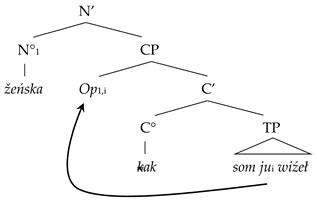 |
2. Background on Lower Sorbian
3. Relative Clauses in Native Lower Sorbian and the Status of ak
3.1. Relative Clauses in Lower Sorbian: The Standard View
| (5) | Ta | žeńska, | kótruž/kakuž | ja | som | wiźeł, | bydli | Barlinju. |
| the | woman | who.acc.fem.sg | I | am | seen | lives | Berlin.loc | |
| ‘The woman that I saw lives in Berlin.’ | ||||||||
| (6) | a. | Ta | žeńska, | kenž | ja | som | (ju) | wiźeł, | bydli | Barlinju. |
| the | woman | rel | I | am | her | seen | lives | Berlin.loc | ||
| b. | Ta | žeńska, | což | ja | som | (ju) | wiźeł, | bydli | Barlinju. | |
| the | woman | rel | I | am | her | seen | lives | Berlin.loc | ||
| c. | Ta | žeńska, | ak | ja | som | (ju) | wiźeł, | bydli | Barlinju. | |
| the | woman | rel | I | am | her | seen | lives | Berlin.loc | ||
| ‘The woman that I saw lives in Berlin.’ | ||||||||||
3.2. Relative Clauses in Native Lower Sorbian
3.3. The Status of ak
| (7) | O | Tij | neymotzneyssy | nymerny | Knijss | Bog | / | kenss | ssij |
| O | ty | nejmocnjejšy | njeměrny | kněz | bog | kenž | sy | ||
| oh | you | mightiest | immortal | Lord | God | rel | are | ||
| Pomotznyk | schyknym | ak se | natebe | spuszayu. | |||||
| pomocnik | wšyknym | ak se | na tebje | spušćaju | |||||
| helper | for all | rel refl | on you | trust | |||||
| ‘Oh you almighty immortal Lord God, who you are the helper for all who trust you.’ | |||||||||
4. ak as a Variant of kak
| (8) | a. | Pón | sy | mógał | wiźeś, | kak | su | byli | how | karony. | ||
| then | are | could | see | how | are | been | here | crows | ||||
| ‘Then you could see that there are crows here.’ | ||||||||||||
| b. | Gaž | wón | to | wiźi, | kak | te | faraje | su | musali | to serbske | wuknuś. | |
| as | he | it | sees | how | the | pastors | are | must | Sorbian | learn | ||
| ‘As he saw it that the pastors had to learn Sorbian.’ | ||||||||||||
| c. | To | jo | naša | mama | wulicowała, | kak | wóni | su šli | pó jsy. | |||
| it | is | our | mum | told | how | they | are gone | in village | ||||
| ‘Our mother used to tell us that they were walking in the village.’ | ||||||||||||
| (9) | a. | Kake | su | wuglědali? |
| how.pl | are | looked | ||
| ‘How did they look?’ | ||||
| b. | Kaka | wóna | wuglěda? | |
| how.fem.sg | she | looks | ||
| ‘How does she look?’ | ||||
| (10) | a. | Gaž | wón | to | wiźi, | kake | te | faraje | su | musali | to serbske | wuknuś. |
| as | he | it | sees | how.pl | the | pastors | are | must | Sorbian | learn | ||
| ‘As he saw it in what way the pastors had to learn Sorbian.’ | ||||||||||||
| b. | To | jo | naša | mama | wulicowała, | kake | wóni | su | šli pó | jsy. | ||
| it | is | our | mum | told | how.pl | they | are | gone in | village | |||
| ‘Our mother used to tell us in what way they were walking in the village.’ | ||||||||||||
| (11) | The manner wh-adverb kak can agree, the complementizer kak must not agree. |
| (12) | a. | manner wh-adverb kak | b. | complementizer kak |
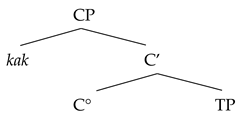 |  |
| (13) | a. | If ak is the manner wh-adverb kak, ak can agree. |
| b. | If ak is the complementizer kak, ak must not agree. |
| (14) | a. * | Ta | žeńska, | ake | wóne | su | (ju) | wiźeli, | bydli | Barlinju. |
| the | woman | rel.pl | they | are | her | seen | lives | Berlin.loc | ||
| ‘The woman that they saw lives in Berlin.’ | ||||||||||
| b. * | Ten | muski, | aka | wóna | jo | (go) | wiźeła, | bydli | Barlinju. | |
| the | man | rel.fem.sg | she | is | him | seen | lives | Berlin.loc | ||
| ‘The man that she saw lives in Berlin.’ | ||||||||||
| (15) |  |
| (16) | 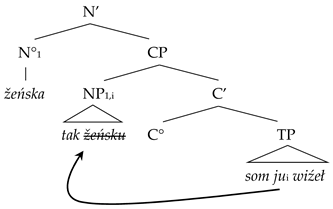 |
| (17) | a. | Ja | znam | jadnog’ | muskeg’, | a | wóna | teke | takog’/* tak | znajo. |
| I | know | a | man | and | she | also | such+agr/ such-agr | knows | ||
| ‘I know a man, and she also knows such a man.’ | ||||||||||
| b. | Ja | mam | jadnu | žeńsku, | a | wón | teke | taku /* tak | ma. | |
| I | have | a | woman | and | he | also | such+agr/ such-agr | has | ||
| ‘I have a wife, and he also has such a wife.’ | ||||||||||
| (18) | a. | taki /* tak | muski. |
| such+agr/such-agr | man | ||
| ‘such a man’ | |||
| b. | taka /* tak | žeńska. | |
| such+agr/such-agr | woman | ||
| ‘such a woman’ | |||
| (19) | a. * | Ta | žeńska, | aka | wóne | su | (ju) | wiźeli, | bydli | Barlinju. |
| the | woman | rel.fem.sg | they | are | her | seen | lives | Berlin.loc | ||
| ‘The woman that they saw lives in Berlin.’ | ||||||||||
| b. * | Ten | muski, | aki | wóna | jo | (go) | wiźeła, | bydli | Barlinju. | |
| the | man | rel.m.sg | she | is | him | seen | lives | Berlin.loc | ||
| ‘The man that she saw lives in Berlin.’ | ||||||||||
5. A Partial COMP Deletion Analysis
5.1. The Structure of Relative Clauses Based on ak in Native Lower Sorbian
| (20) | a. | Ta | žeńska, | ak | ja | som | ju | wiźeł, | bydli | Barlinju. |
| the | woman | rel | I | am | her | seen | lives | Berlin.loc | ||
| ‘The woman that I saw lives in Berlin.’ | ||||||||||
| b. | … žeńskai … [CP … jui …]. | |||||||||
| c. | … žeńskai … [CP … XPi,1 … __i,1 → jui,1 …]. | |||||||||
| (21) * | Ta | žeńska, | ak | ja | som | [(ju) | a | móju | mamu] | wiźeł, | bydli | Barlinju. |
| the | woman | rel | I | am | her | and | my | mother | seen | lives | Berlin.loc | |
| ‘The woman that I saw her and my mother lives in Berlin.’ | ||||||||||||
| (22) | a. | Wšykne | su | chwalili, | kaku | my | mamy | [t dobru | wódu ]. |
| all | are | praised | what | we | have | good | water | ||
| ‘All praised what good water we have.’ | |||||||||
| b. | Běle | štrumpy | wěm, | až | njejsom | t měła | . | ||
| white | socks | I.know | that | not.am | had | ||||
| ‘White socks I know that I didn’t have.’ | |||||||||
| (23) | a. * | Ta | žeńska, | ak | znaju | [ jej | gólca], | bydli | Barlinju. | |||
| the | woman | rel | I.know | her | boy | lives | Berlin.loc | |||||
| ‘The woman whose son I know lives in Berlin.’ | ||||||||||||
| b. * | Ta | žeńska, | ak | se | myslim, | až | som | (ju) | wiźeł, | bydli | Barlinju. | |
| the | woman | rel | refl | I.think | that | am | her | seen | lives | Berlin.loc | ||
| ‘The woman that I think I have seen lives in Berlin.’ | ||||||||||||
| (24) | 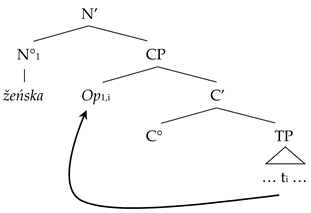 |
| (25) | 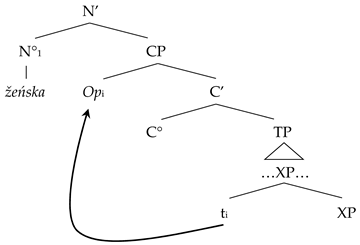 |
| (26) | a. | Wat | voor | boeken | heeft | Jan t | verkocht? |
| what | for | books | has | Jan | sold | ||
| b. | Wat | heeft | Jan | [t voor | boeken] | verkocht? | |
| what | has | Jan | for | books | sold | ||
| ‘What books did Jan sell?’ | |||||||
| (27) | a. ? | Wat | voor | boeken | vraag | jij | je | af, | wanneer | Jan | t | gekocht | heeft? |
| what | for | books | ask | you | refl | prt | when | Jan | bought | has | |||
| b. * | Wat | vraag | jij je | af, | wanneer | Jan | [t voor | boeken ] | gekocht | heeft? | |||
| what | ask | you refl | prt | when | Jan | for | books | bought | has | ||||
| ‘What books do you wonder when Jan has bought?’ | |||||||||||||
| (28) | a. | Wat | voor | boeken | heeft | Jan | niet | t | gelezen? |
| what | for | books | has | Jan | not | read | |||
| b. * | Wat | heeft | Jan | niet | [t voor boeken] | gelezen? | |||
| what | has | Jan | not | for books | read | ||||
| ‘What books didn’t Jan read?’ | |||||||||
5.2. The Analysis
| (29) | a. | k → Ø/[CP Op [C° [_ak]] ] k is deleted when it is the first consonant of the complementizer kak |
| b. |  |
| (30) | a. | De | Hans | hed | nid | gwüsst, | wem | (d)ass | är | t | söll | aalüte. |
| the | Hans | had | not | known | who | that | he | should | call | |||
| ‘Hans didn’t know who he should call?’ | ||||||||||||
| a’. | Wem | hed | är | gseid, | t’ (d)ass | är | das | t | wiitersägi? | |||
| who | had | he | said | that | he | that | tells | |||||
| ‘Who did he say that he should tell that?’ | ||||||||||||
| b. | d-deletion may apply if SpecCP is filled by (i) an A’-moved XP or (ii) its trace. | |||||||||||
| (31) | a. | Ik | wit net, | hwa | *dat/*Ø/√‘t | hjirre | so’n | rommel | make hat. |
| I | know not | who | that | here | such=a | mess | made has | ||
| ‘I don’t know who made such a mess here.’ | |||||||||
| a’. | de | minister, | dy | *dat/*Ø/√‘t | in protte | tasein | hie. | ||
| the | minister | rel | that | much | promised | had | |||
| ‘the minister that promised a lot.’ | |||||||||
| b. | dat is reduced to ‘t if SpecCP is occupied by an overt element. | ||||||||
| (32) | a. | [NP kikóloombé] |
| ‘cleaning shell’ | ||
| b. | [NP kikólombe chaángu] | |
| ‘my cleaning shell’ | ||
| c. | [NP kikólombé [AP kikeéle/*kikelé] chaángu] | |
| ‘my red cleaning shell’ | ||
| (Kaisse, 1985, p. 178) |
6. Fronted Resumptive Pronouns
| (33) | a. | Źo | jo | ten | luź, | tomu | ak | ja | som | cora | te pjenjeze | pžyzycyła. |
| where | is | the | man | him | rel | I | am | yesterday | the money | given | ||
| ‘Where is the man who I yesterday gave the money to?’ | ||||||||||||
| b. | To | jo | ta | droga, | na | tej | ak | smy | pjerjei | šli. | ||
| that | is | the | road | on | it | rel | we.are | earlier | walked | |||
| ‘This is the road on which we used to walk.’ | ||||||||||||
| (34) | a. | Mój | stary | nan, | wot | togo | ak | něnt | som | pówědał. | ||
| my | old | father | of | him | rel | now | am | told | ||||
| ‘my grandfather who I told you about.’ | ||||||||||||
| b. | Smy | měli | jadnu | flašku, | z teju | ak | smy | se | pón | chwalili | pó jsy. | |
| we.are | had | a | bottle | with it | rel | we.are | refl | then | walked | in village | ||
| ‘We had a bottle with which we were walking through the village.’ | ||||||||||||
| (35) | a. | Ja | znam | jadnu | žeńsku, | wót teje | ak | cu | śi | něco | wulicyś. |
| I | know | a | woman | of her | rel | I.want | you | something | tell | ||
| ‘I know a woman that I want to tell you something about.’ | |||||||||||
| b. | A: | Madlena | jo žeńska, | ak njocoš | z neju | rejowaś. | |||||
| Madlena | is woman | rel not.you.want | with her | dance | |||||||
| ‘Madlena is a woman that you don’t want to dance with.’ | |||||||||||
| B: | Ně, ně, | Madlena | jo žeńska | z teju | ak cu | rejowaś. | |||||
| no no | Madlena | is woman | with her | rel I.want | dance | ||||||
| ‘No no, Madlena is a woman that I do want to dance with.’ | |||||||||||
| c. | A: | Z kakeju | žeńsku | mógu hyś | na reju? | ||||||
| with which | woman | I.can go | on dance | ||||||||
| ‘With which woman can I go dancing?’ | |||||||||||
| B: | Madlena | jo žeńska, | z teju ak | móžoš hyś | na reju! | ||||||
| Madlena | is woman | with her rel | you.can go | on dance | |||||||
| ‘Madlena is a woman with whom you can go dancing!’ | |||||||||||
| (36) | 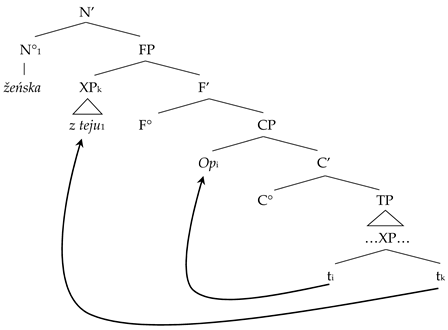 |
| (37) | * | Ta | žeńska, | tu | ak | se | myslim, | až | som | t | wiźeł, | bydli | Barlinju. |
| the | woman | her | rel | refl | I.think | that | am | seen | lives | Berlin.loc | |||
| ‘The woman that I think I have seen lives in Berlin.’ | |||||||||||||
7. Native Lower Sorbian vs. Czech and German
| (38) | A | vochutnalas | tu | buchtu, | jak | (ji) | dělali | ty | maldý? |
| and | you.tasted | the | cake | how | it | made | the | young ones | |
| ‘And did you taste the cake that the young ones made?’ | |||||||||
| (39) | a. * | Každej | teenager, | jak | dneska | ráno | vstane | si, | pustí | Evropu 2. |
| every | teenager | how | today | morning | gets.up | refl | turns.on | Europe 2 | ||
| ‘Every teenager that gets up today in the morning turns on Europe 2.’ | ||||||||||
| b. * | Nejdelší | šichtu, | jak | můžeš | mít tak, | to je | do | vod 9 | do 11. | |
| longest | shift | how | you.can | have so | that is | of | from 9 | to 11 | ||
| ‘The longest shift you can have is from 9 to 11.’ | ||||||||||
| (40) | a. | Wacen | njej | how | nicht, ak | serbske | pówědał. | ||
| else | not.is | here | no one rel | Sorbian | spoken | ||||
| ‘Here is no one else that would speak Sorbian.’ | |||||||||
| b. | Tam | su | te | rědnjejše | štuki, | ak ja | som | namakała. | |
| there | are | the | most beautiful | pieces | rel I | am | found | ||
| ‘There are the most beautiful pieces that I found.’ | |||||||||
| c. | Kuždy | gólc, | ak | ma sam | doma | konja. | |||
| every | boy | rel | has self | at home | horse | ||||
| ‘every boy that himself owns a horse.’ | |||||||||
| d. | Ta | slědna | šotša | mojog nana, | ak jo | doma | krydnuła. | ||
| the | last | sister | of my father | rel is | house | got | |||
| ‘the last sister of my father, who inherited the house.’ | |||||||||
| (41) | Maria | hat | einen | Pullover | gekauft, | wie | sie | ihn | bei | Karstadt | gesehen | hat. |
| Maria | has | a | sweater | bought | how | she | it | at | Karstadt | seen | has | |
| ‘Maria bought a sweater as she saw at Karstadt.’ | ||||||||||||
| (42) | Marija | jo | jaden | pulower | kupiła, | ak | wóna | jo | jen | wiziła | Karstaśe. |
| Marija | is | a | sweater | bought | how | she | is | it | seen | Karstadt.loc | |
| ‘Marija bought a sweater that she saw at Karstadt.’ | |||||||||||
8. Summary and Conclusions
Funding
Institutional Review Board Statement
Informed Consent Statement
Data Availability Statement
Acknowledgments
Conflicts of Interest
| 1 | These villages are Dissen (Dešno), Striesow (Strjažow), Drachhausen (Hochoza), Schmogrow (Smogorjow), Fehrow (Prjawoz), Drehnow (Drjenow), Turnow (Turnow), Tauer (Turjej), Peitz (Picnjo), Jänschwalde (Janšojce), Bärenbrück (Barbuk), and Heinersbrück (Móst); the names in parentheses are the Lower Sorbian names of the villages. |
| 2 | For example, dwórnišćo ‘train station’ instead of bonof, based in German Bahnhof; casnik ‘newspaper’ instead of cajtunga, based in German Zeitung; cytaś ‘to read’ instead of lazowaś, based on German lesen; and žyś ‘to live’ instead of labowaś, based on German leben. These puristic tendencies ignore that the loanwords have been phonologically and morphologically completely assimilated to the grammatical system of Native Lower Sorbian. |
| 3 | More on the DoBeS project can be found at dobes.mpi.nl, and further information about the subproject on Lower Sorbian at dobes.mpi.nl/projects/lower_sorbian and at dolnoserbski.de/dobes/info (accessed on 3 May 2025). |
| 4 | dolnoserbski.de/dobes; no registration is needed to use the corpus. Unfortunately, the user interface is only in German or Lower Sorbian, and the translations of the conversations are also only in German. |
| 5 | I would have appreciated to collect judgments from more informants, but this is nearly impossible to achieve. On the one hand, the use of Native Lower Sorbian is typically restricted to private conversations among native speakers. On the other hand, given the stigmatization the majority of native speakers experienced in their youth, they are usually reluctant to use it with strangers. In addition, native speakers often downplay their ability to speak the language and switch to German instead. |
| 6 | The stem kótr- also has the variant kótar-, and the stem kak- also has the variants kajk- or kaj-. I ignore this variation throughout this paper. |
| 7 | The strategy employing kak- + ž is a peripheral one in Lower Sorbian and is only mentioned for completeness. |
| 8 | Ak can be extended to ako and akol. Ak is more frequent than ako, and ako, in turn, is more frequent than akol. In the DoBeS corpus, there are 2707 hits for ak, 587 for ako, and 115 for akol. Given this distribution, I treat ak as basic and ako and akol as derived (even though the literature treats ako as basic and ak as ‘non-standard’ (Bartels & Spiess, 2012, p. 231)). Consequently, whenever I speak of ak in this paper, this is meant to include ako and akol. The nature of these extensions and their different frequencies is unclear to me. These extensions are not unique to ak, but they are also found with the complementizers hejnak ‘as if’, až ‘that’, gaž ‘when’, with the coordinator ab ‘or’, and with the adverbs tam ‘there’, how ‘here’, ně(n)t ‘now’, and juž ‘already’. ab and the adverbs, in turn, differ from the complementizers in that they also sporadically allow the extension -or. What unites these items is equally unclear to me. Since these extensions and their distribution are independent of the topic of this paper, I leave them to further research. |
| 9 | The numbers were gathered through a search in the Lower Sorbian text corpus (dolnoserbski.de/korpus/comfort) for texts from 1990. |
| 10 | Of these 9032 hits, 9013 hits are for kotr- + ž, and only 19 are hits for kak- + ž (cf. note 7). |
| 11 | The number for ak can only be estimated. ak and its variants (cf. note 8) are also used in embedded clauses other than relative clauses, namely, in comparative clauses and temporal adverbial clauses (in this paper, I ignore why this is so). The total number for ak in embedded clauses is 8004. Since the other uses of ak occur way more frequently than ak in relative clauses, I estimated that only 25% of the 8004 hits for ak represent ak as a relativizer. This estimation was based on manually checking the first 100 hits. |
| 12 | The number for což can also only be estimated. There are, in total, 3711 hits for což, but these include což as the relative pronoun in free relatives and in light-headed relative clauses (Citko, 2004). Also, here, I manually checked the first 100 hits, of which only a handful had což as a relativizer for regular relative clauses. I therefore estimated that only 5% of all occurrences of což represent the relativizer. |
| 13 | Curiously, although Fasske (1995) states quite explicitly that ak plus resumption is, in fact, the only strategy to form relative clauses in Native Lower Sorbian, this finding has received basically no attention so far in the literature. It is not mentioned in papers devoted specifically to relative clauses in Lower Sorbian from after 1995 (Gutschmidt, 1999; Bartels & Spiess, 2012), nor in the textbooks for Lower Sorbian (for example Hannusch, 2009). The only exception is Pankau (2021, p. 2, fn. 1), who mentions this briefly when discussing the differences between Standard and Native Lower Sorbian. |
| 14 | The first line gives the Lower Sorbian example in the original orthography; the second line gives it in today’s standard orthography. |
| 15 | “Wohl ähnlich wie o[ber]s[orbisch] älter ač, jetzt hač, u[nd] n[ieder]s[orbisch] älter ac ≤ urspr[ünglich] emphat[ischer] Part[ikel] *a, erweitert durch altes interrogatives *kъ bzw. *ko.” (Schuster-Šewc, 2024, p. 4). |
| 16 | -ogo marks masc.gen.sg or neut.gen.sg of the 3.sg.masc pronoun wón and of the determiners ten ‘the’, jaden ‘a’, and wšykny ‘all’; -ego marks masc.gen.sg or neut.gen.sg of adjectives and all other determiners (like kuždy ‘every’ and młogi ‘some’). |
| 17 | It is, in fact, quite clear what is responsible for the dropping of o of the inflectional suffixes -ogo and -ego. As noted in several grammar (Janaš, 1984; Mucke, 1891, pp. 134–136), the final vowel of a bisyllabic ending in the singular inflection of adjectives, determiners, and pronouns can optionally be dropped. This is not restricted to o, but it also includes u, turning, for example, the dat.masc.sg suffixes -emu and -omu into -em and -om, and e, so that the gen.fem.sg suffix -eje becomes -ej. |
| 18 | There is a problem with this statement, but it is only apparent. As pointed out in note 8, certain complementizers, the coordinator ab ‘or’, and adverbs can be extended with -o and -ol (ab and the adverbs also with -or). Among the adverbs, how and tam stand out because they surface as howko/howkol/howkor and tamko/tamkol/tamkor, respectively. So it seems that at least howko and tamko feature the suffix -ko, to which -ol and -or can be added (followed by the deletion of one of the two o’s). But, as already said, this problem is only apparent. Instead of assuming a suffix -ko, it is more likely that how and tam feature an underlying k, which gets deleted due to a phonological constraint banning final [wk] and [mk] morpheme-internally. The correctness of this analysis is corroborated by inspecting all words that end in [wk] and [mk]. It turns out that they all involve a suffix k, that (i) has a nominalizing function, (ii) indicates the diminutive when attached to a noun, or (iii) indicates the origin of a person when attached to a toponym. Consequently, in the words ending in [wk] and [mk], the k is invisible to the constraint because it is a separate morpheme. In /howk/ and /tamk/, however, this is not the case, so the k gets deleted. When -o,-ol, or -or are added, the sequences [wk] and [mk] are no longer morpheme-finally, so the deletion of k must not apply. |
| 19 | The choice between the two variants for the accusative depends, as is typical for West Slavic languages, on animacy. If the accusative DP refers to an inanimate referent, the accusative takes a special form. If it refers to an animate referent, the accusative is identical to the genitive. |
| 20 | The agreement also excludes the option of that being a demonstrative in English relative clause. If that were a demonstrative, it should agree with the head noun with respect to number, contrary to fact (the men that I saw vs. * the men those I saw). |
| 21 | This implies that the presence and absence of resumptive pronouns in Native Lower Sorbian cannot be tied to islands. This is, indeed correct, as was already noted in the literature (Mucke, 1911–1915, p. 3; Bartels & Spiess, 2012). The presence of resumptives is instead tied to the morphosyntactic make-up of the head noun and the relativized element, such that certain mismatches require a resumptive. |
| 22 | One reviewer suggested a seductive alternative, namely, that the head noun žeńska and the complementizer kak are phonologically similar so that the kak’s initial k is deleted in order to guarantee phonological dissimilarity or to avoid haplology. Although such processes are attested, k-deletion is certainly not among them because k-deletion applies regardless of the phonological shape of the preceding word, cf. examples (33a), (35c), (40), and (42). |
References
- Andersen, H. (1986). Sandhi phenomena in the languages of Europe. De Gruyter. [Google Scholar]
- Bartels, H., & Spiess, G. (2012). Restrictive relative clauses in the Sorbian languages. Language Typology and Universals, 65(3), 221–245. [Google Scholar] [CrossRef]
- Bayer, J. (1984). COMP in Bavarian syntax. The Linguistic Review, 3(3), 209–274. [Google Scholar] [CrossRef]
- Behaghel, O. (1928). Deutsche syntax III. Carl Winter. [Google Scholar]
- Brand, K., & Penner, Z. (1995). The rule of d-deletion in Swiss German and the internal structure of COMP. In Z. Penner (Ed.), Topics in Swiss German syntax (pp. 29–58). Peter Lang AG. [Google Scholar]
- Carstens, V., & Diercks, M. (2013). Agreeing how? Implications for theories of agreement and locality. Linguistic Inquiry, 44(2), 179–237. [Google Scholar] [CrossRef]
- Citko, B. (2004). On headed, headless, and light-headed relatives. Natural Language & Linguistic Theory, 22(1), 95–126. [Google Scholar]
- Corver, N. (1990). The syntax of left branch extractions [Ph.D. thesis, Universiteit van Tilburg]. [Google Scholar]
- Corver, N. (2017). Subextraction. In M. Everaert, & H. van Riemsdijk (Eds.), The blackwell companion to syntax. Volume IV (pp. 1–51). Blackwell. [Google Scholar]
- Fasske, H. (1995). Sorbischer sprachatlas 15. syntax. Domowina Verlag. [Google Scholar]
- Gutschmidt, U. (1999). Zum niedersorbischen Relativsatz. Lětopis, 46, 122–133. [Google Scholar]
- Hannusch, E. (2009). Niedersorbisch praktisch und verständlich. Domowina Verlag. [Google Scholar]
- Hauptmann, J. G. (1984). Nieder-Lausitzsche Wendische Grammatica. Domowina Verlag. (Original work published 1761). [Google Scholar]
- Hinterhölzl, R. (2023). On perceptive evidential wie-clauses in German: A situation-based approach. In Ł. Jędrzejowski, & C. Umbach (Eds.), Non-interrogative subordinate wh-clauses (pp. 207–238). Oxford University Press. [Google Scholar]
- Hornsby, M. (2015). Revitalizing minority languages: New speakers of Breton, Yiddish and Lemko. Palgrave Macmillan. [Google Scholar]
- Janaš, P. (1984). Niedersorbische grammatik. Domowina Verlag. [Google Scholar]
- Jodlbauer, R., Spiess, G., & Steenwijk, H. (2001). Die aktuelle situation der niedersorbischen Sprache. Domowina Verlag. [Google Scholar]
- Kaisse, E. M. (1985). Connected speech. The interaction of syntax and phonology. Academic Press. [Google Scholar]
- Kaisse, E. M., & Zwicky, A. (1987). Phonology yearbook 4: Syntactic conditions on phonological rules. Cambridge University Press. [Google Scholar]
- Korsah, S., & Murphy, A. (2024). The absence of islands in Akan: The role of resumption. Languages, 9(4), 127. [Google Scholar] [CrossRef]
- Legate, J. A. (2010). On how is used instead of that. Natural Language & Linguistic Theory, 28(1), 121–134. [Google Scholar]
- Mucke, E. (1891). Historische und vergleichende Laut- und Formenlehre der niedersorbischen (niederlausitzisch-wendischen) Sprache. Hirzel. [Google Scholar]
- Mucke, E. (1911–1915). Słownik dolnoserbskeje rěcy a jeje narěcow. A-N. Verlag der Russischen und Čechischen Akademie der Wissenschaften. [Google Scholar]
- Odden, D. (1996). The phonology and morphology of Kimatuumbi. Oxford University Press. [Google Scholar]
- Pankau, A. (2018). The Matching Analysis of relative clauses: An argument from antipronominal contexts. Journal of Comparative German Linguistics, 21(2), 189–245. [Google Scholar] [CrossRef]
- Pankau, A. (2021). Left branch extraction in lower Sorbian. Journal of Slavic Linguistics, 29, 1–14. [Google Scholar] [CrossRef]
- Pankau, A. (2023). Comparative relatives in German. In Ł. Jędrzejowski, & C. Umbach (Eds.), Non-interrogative subordinate wh-clauses (pp. 274–327). Oxford University Press. [Google Scholar]
- Pankau, A. (2024, May 16–19). Agreeing how and the directionality of AGREE—Evidence from Sorbian. FASL 33, Dalhousie University, Halifax, UK. [Google Scholar]
- Reuland, E. (1979). Principles of subordination and construal. Dijkstra Niemeyer BV. [Google Scholar]
- Rizzi, L. (1997). The fine structure of the Left Periphery. In L. Haegeman (Ed.), Elements of grammar (pp. 281–337). Kluwer Academic Publishers. [Google Scholar]
- Ross, H. (1984, February 17–20). Inner islands. Proceedings of the Tenth Annual Meeting of the Berkeley Linguistics Society (pp. 258–265), Berkeley, CA, USA. [Google Scholar]
- Sande, H. (2024, October 17–18). Discontinuous harmony in Guébie: Consequences for cyclic spell out. NELS 55, Yale University, New Haven, CT, USA. [Google Scholar]
- Schuster-Šewc, H. (1959). Albin Moller. Niedersorbisches Gesangbuch und Katechismus. Budissin 1574. Akademie Verlag. [Google Scholar]
- Schuster-Šewc, H. (2024). Historisch-etymologisches Wörterbuch der sorbischen Sprachen. Band I. Domowina Verlag. [Google Scholar]
- Šimík, R., & Sláma, J. (2023). Czech evidential relatives introduced by jak ‘how’: Recognitional cues for the hearer. In Ł. Jędrzejowski, & C. Umbach (Eds.), Non-interrogative subordinate wh-clauses (pp. 239–273). Oxford University Press. [Google Scholar]
- Tiersma, P. M. (1985). Frisian reference grammar. Foris publications. [Google Scholar]
- Vangsnes, Ø. A. (2008). Decomposing manner how in colloquial Scandinavian. Studia Linguistica, 62(1), 119–141. [Google Scholar] [CrossRef]
- Vangsnes, Ø. A. (2015). The polyfunctionality of which in Övdalian. In K. Bentzen, H. Rosenkvist, & J. B. Johannessen (Eds.), Studies in Övdalian morphology and syntax (pp. 137–165). Benjamins. [Google Scholar]
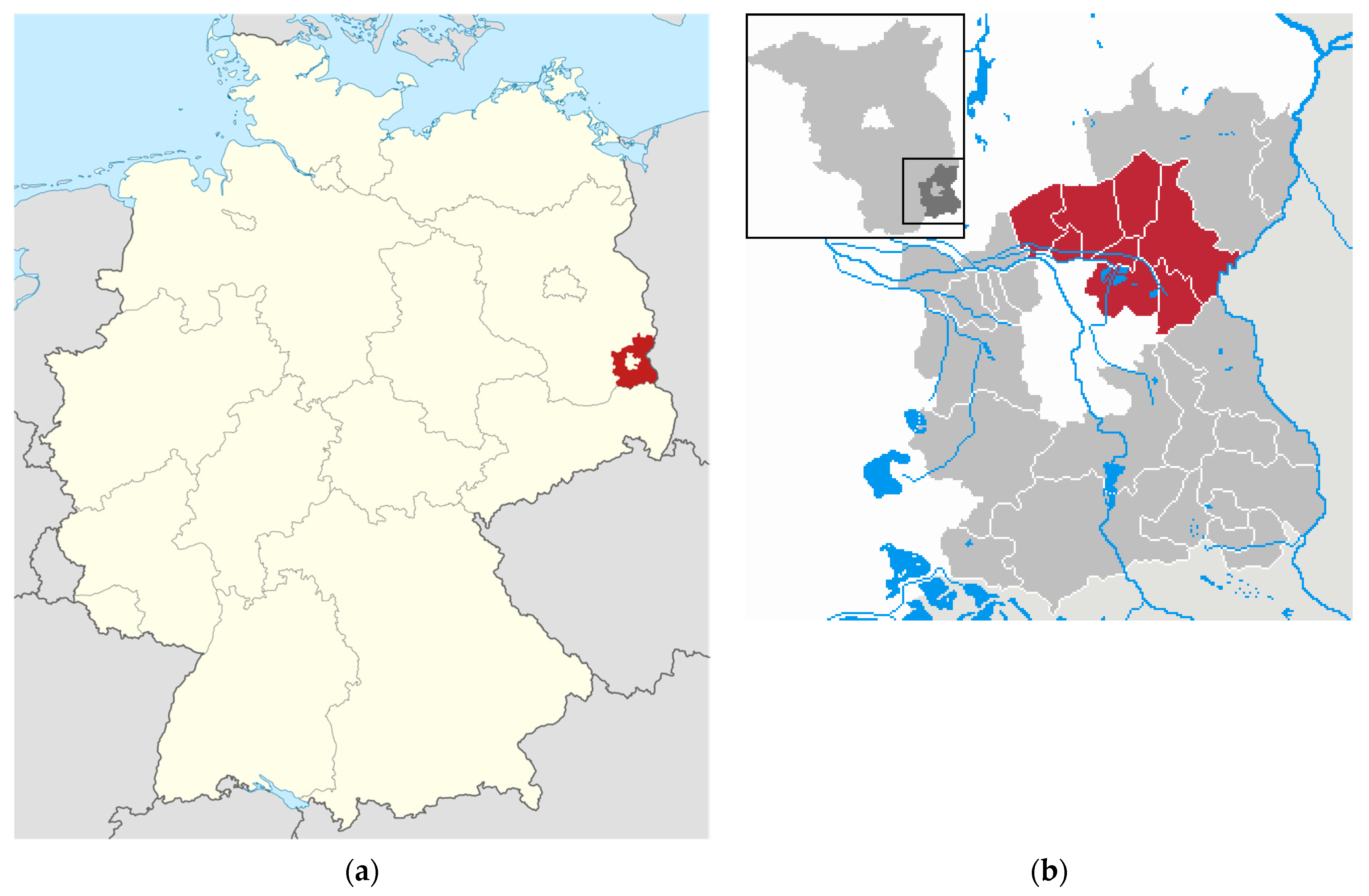
| kótr-/kak- + ž | kenž | ak | což |
|---|---|---|---|
| 9032 | 5823 | ≈2000 | ≈150 |
| kótr-/kak- + ž | kenž | ak | což |
|---|---|---|---|
| 5 | 0 | 157 | 12 |
| kótr-/kak- + ž | kenž | ak | což |
|---|---|---|---|
| 5 | 13 | ≈850 | ≈30 |
| kótr-/kak- + ž | kenž | ak | což |
|---|---|---|---|
| 47,440 | 32,285 | ≈9700 | ≈750 |
| sg | du | pl | |||
| m | neut | fem | |||
| nom | kaki | kake | kaka | kakej | kake |
| acc | kakeg(o)/kaki | kaku | kakeju/kakej | kakich/kake | |
| dat | kakem(u) | kakej | kakima | kakim | |
| gen | kakeg(o) | kakej(e) | kakeju | kakich | |
| ins | kakim | kakeju | kakima | kakimi | |
| loc | kakej | kakich | |||
Disclaimer/Publisher’s Note: The statements, opinions and data contained in all publications are solely those of the individual author(s) and contributor(s) and not of MDPI and/or the editor(s). MDPI and/or the editor(s) disclaim responsibility for any injury to people or property resulting from any ideas, methods, instructions or products referred to in the content. |
© 2025 by the author. Licensee MDPI, Basel, Switzerland. This article is an open access article distributed under the terms and conditions of the Creative Commons Attribution (CC BY) license (https://creativecommons.org/licenses/by/4.0/).
Share and Cite
Pankau, A. Relative Clauses in Native Lower Sorbian and the Relativizer how. Languages 2025, 10, 125. https://doi.org/10.3390/languages10060125
Pankau A. Relative Clauses in Native Lower Sorbian and the Relativizer how. Languages. 2025; 10(6):125. https://doi.org/10.3390/languages10060125
Chicago/Turabian StylePankau, Andreas. 2025. "Relative Clauses in Native Lower Sorbian and the Relativizer how" Languages 10, no. 6: 125. https://doi.org/10.3390/languages10060125
APA StylePankau, A. (2025). Relative Clauses in Native Lower Sorbian and the Relativizer how. Languages, 10(6), 125. https://doi.org/10.3390/languages10060125





